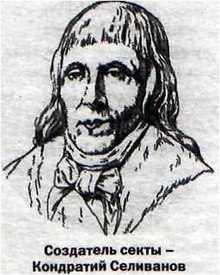Skoptsy
They were best known for practising emasculation of men, the mastectomy and female genital mutilation of women in accordance with their teachings against sexual lust.
[7] They believed that human genitals were a mark of original sin, and that after the expulsion from the Garden of Eden, Adam and Eve had the halves of the forbidden fruit grafted onto their bodies, forming testicles and breasts.
"[3] According to ecclesiastical historian Diarmaid MacCulloch, the belief originated in a mistranslation by its founder Kondraty Selivanov of a biblical command in Genesis 1:28 as плотитесь (“castrate yourselves”) rather than плодитесь (“be fruitful”).
Its founder was a runaway peasant, later known as Kondratiy Ivanovich Selivanov, a former adherent of a Khlysty sect of Akulina Ivanovna in the Oryol Governorate.
He claimed to be the Tsar's father, Peter III (who had been assassinated in 1762), following which Paul I had him confined to the madhouse at Obukhov hospital.
Peter had been popular among the Raskolniks (dissidents) because he granted them liberty of conscience, and among the peasants because when pillaging the convents[clarification needed] he divided their lands among the labourers.
Despite the furious investigations of the Third Department (the tsar's secret police), Skoptisism did not disappear after Selivanov's death, and scandals continued to arise.
Although Skoptisism prescribed castration as a precondition for entering paradise, only a minority of members (703 men and 100 women) had undergone bodily mutilation.
[15] Alexandre Dumas, père, writes about the sect, calling them scopsis, towards the end of his account of his journey through Caucasia, "Le Caucase, Memoires d'un Voyage", 1858,[16] where he met them in Georgia.
In the book The Idiot, Fyodor Dostoevsky mentions that the home of Parfyon Semyonovich Rogozhin is rented to Skoptsy tenants.
Repressive measures were tried along with ridicule: male Skoptsy were dressed in women's clothes and paraded wearing fools' caps through the villages.
Caragiale acknowledges that toward the end of the 19th century all the horse-powered cabs in Bucharest were driven by Russian Skoptsy (Scopiți in Romanian).
[18] Increased repression and collectivization under the Soviet Union reduced the numbers to a reported few thousand in 1929, when the authorities staged a widely publicized mass trial against the sect.
[19] Leon Trotsky, in a report from Romania in 1913, wrote about the Skoptsy in the Dobruja region who worked as horse-cab drivers and played a predominant role in the local horse trade.
[20] Patrick Leigh Fermor in The Broken Road describes his encounters (in 1933/4) with two "Skapetz" (sic) in a Bucharest tavern and as a passenger in their horse-drawn cabs: "They conversed in oddly high-pitched voices in a language that sounded at first like Bulgarian but soon turned out to be—judging by its shifting vowels and liquid sounds—Russian.

